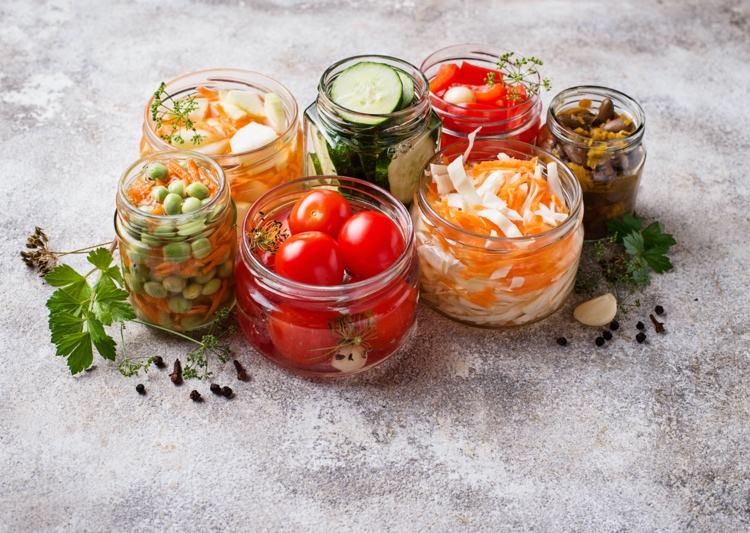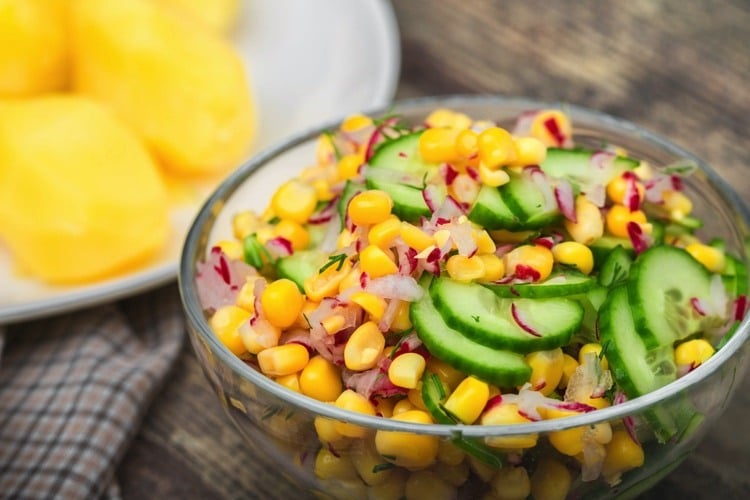Diet for histamine intolerance: list of allowed foods and tips
If you find that your body is on different foods – e.g. Spinach, tomatoes, red wine and sauerkraut – reacting with symptoms, it is not an allergy. Instead, you may have a so-called histamine intolerance because all of these foods are high in histamine. For people with histamine intolerance, a low-histamine diet can help to alleviate these symptoms. As a little help, you will find a list of permitted foods and useful nutrition tips in this article.
What is histamine intolerance?

Histamine is a natural messenger substance that is formed in the body and is also found in certain foods. In situations with “real” allergies, your body releases histamine, and this histamine, in turn, provokes what we call the allergic reaction.
Histamine intolerance is not a real allergy. Rather, it refers to a reaction that some people have to foods with a high content of naturally occurring histamine. People with histamine intolerance often have low levels of one of two very specific enzymes – diamine oxidase (DAO) and histamine N-methyltransferase (HNMT) – that process histamine in your body. If there are not enough of these enzymes to process histamine, the messenger can build up over time and cause symptoms throughout the body.
Histamine intolerance symptoms and diagnosis

Histamine intolerance, also known as enteral (i.e., intestinal) histaminosis, is a very rare condition that is estimated to affect approximately 1% of the population. It is also very difficult to diagnose. The most common symptoms of histamine intolerance are migraines, indigestion such as diarrhea, hot flashes, hives, eczema and allergic rhinitis (the medical term for hay fever). Eating a large amount of histamine-rich foods can trigger this reaction, but figuring out exactly which triggers are can be complicated.
Histamine intolerance test

If food allergies and other gastrointestinal disorders such as celiac disease have been ruled out, your doctor can test you for histamine intolerance. Since conventional allergy tests such as the prick test (skin puncture test) and the IgE antibody test can often be unreliable, a DOA blood test is recommended. A blood sample is used to determine the concentration of the enzyme diamine oxidase (DOA), which breaks down histamine in the intestine. A DAO deficiency in combination with an increased histamine level can reinforce suspicions of histamine intolerance.
Histamine intolerance treatment and rotation diet

If a doctor detects histamine intolerance, you should change your diet and follow a low-histamine diet. This type of diet is very restrictive and should not be followed in the long term. It is recommended that you get personalized advice from a registered nutritionist to ensure you get enough nutrients and calories. Since every person reacts differently to histamine, an individual meal plan should be drawn up. Depending on the symptoms, foods are removed from the menu and then gradually reintroduced.
To discover the triggers, it’s also important to keep a food diary for a few weeks and monitor your symptoms. If you find that your symptoms have improved, you can temporarily omit this food and try to add it back to your diet after about a month. Working with a nutritionist will help you balance your nutrient intake and reduce stress.
Medicines and supplements

While a histamine-free diet is the only long-term treatment for histamine intolerance, there are certain nutritional supplements or medications, such as Antihistamines that can be taken to improve symptoms. Antiallergics with diphenhydramine (or diphenhydramine hydrochloride) can be useful, for example, if you have accidentally eaten a histamine-containing food or if you have to take a medication that can block the activity of the histamine-processing enzyme.
There are also dietary supplements that some doctors recommend for people with histamine intolerance. These include vitamin C and vitamin B6 (which can stimulate the activity of these histamine-processing enzymes in your body) as well as capsules with the DAO enzyme to supplement the natural supply of the body. Sometimes calcium, copper, zinc and other micronutrients can also be prescribed.
Histamine intolerance food list

You can eat this with histamine intolerance:
Fresh fruit: Apples, pomegranates, blueberries, melon, cranberries, apricots, cherries, pears, plums, peaches, rhubarb (almost all except citrus fruits, strawberries, avocado)
Fresh vegetables: Arugula, green lettuce, cabbage, zucchini, corn, asparagus, garlic, artichokes, broccoli, carrots, onions, radishes, peppers, cucumbers, spaghetti squash, etc. (all vegetables except those on the no-go list)
Fresh herbs: Basil, parsley, oregano, rosemary, coriander, thyme, turmeric
Gluten-free cereals: Quinoa, brown rice, oatmeal, rice waffles
Dried legumes: Chickpeas, black beans, kidney beans
Starchy vegetables: Sweet potato, yam, butternut squash, winter squash
Fresh meat and fish: Chicken, turkey, salmon, sea fish, lean ground beef, lamb
Carob powder (an alternative to chocolate)
Milk substitute: Almond milk, hemp milk, coconut milk
Hemp seeds, linseed, chia seeds
Olive oil, coconut oil
egg yolk
beverages: all non-citrus fruit juices, vegetable juices, herbal tea, yogi tea
These foods should be avoided with histamine intolerance:

Hard cheese: Parmesan, Cheddar, Gouda, Camembert, Swiss cheese
Fermented food and beverages: Sauerkraut, pickles, pickled vegetables, kefir, kombucha
Dairy products such as yogurt, sour cream and buttermilk (the more mature, the more histamine contains)
Processed meat: Cold cuts, bacon, sausage, salami, ham, chorizo, hot peppers
Alcohol and alcoholic beverages
Types of beer such as wheat beer
protein
Tea (black tea, yerba mate tea, green tea)
soy
Peanuts, walnuts, cashews
Smoked fish and canned fish (such as salmon and tuna)
Mussels, shrimp
Certain types of vegetables: Spinach, tomatoes, eggplants, mushrooms, garlic
Certain types of fruit: Strawberries, raspberries, kiwi, grapes, bananas, cherries, citrus fruits (papaya, orange, lemon, pineapple)
avocado
Dried fruit
Spices and sauces: Ketchup, chili powder, cinnamon, cloves, vinegar
Packaged and processed foods: Snacks, cookies, sweets
Food additives, preservatives and colors
Licorice, cocoa, chocolate, marzipan, nougat
yeast

Meat and fish: The longer a food is stored or processed, the more histamine is formed in it. At best, you only buy meat and fish on the day of preparation.
Starchy vegetables: Starchy vegetables such as sweet potatoes, yams and butternut squash are rich in vitamins A, C and other antioxidants. They are healthy, high-fiber, healthy foods that can fill you up and replace processed grains.

Carob: Carob powder is rich in antioxidants and a good alternative to cocoa and chocolate. It is also gluten free and contains bioactive compounds like fiber, polyphenols, flavonoids, cyclitols (like d-pinitol) and tannins. These compounds have anti-cancer properties and have been linked to a variety of health benefits including controlling blood sugar (glycemia), lowering cholesterol, and more. Here you can see a few interesting recipes with carob powder.

Fresh herbs: Fresh herbs can add flavor and nutritional value to any meal without adding calories and fat. You can spice up any vegetable pan or salad and are a wonderful and colorful addition to any meal plan. You can also create your own herb garden on the windowsill or on the balcony.
Nut milk: Enriched with calcium and vitamin D, nut milk has fewer calories and saturated fatty acids than cow’s milk and is ideal as a milk substitute for people who are vegan or vegetarian.
Coffee with histamine intolerance

Caffeine blocks the enzyme diamine oxidase. Many people with histamine intolerance therefore choose healthy coffee substitutes such as Grain coffee or carob coffee (carob coffee). You can still enjoy coffee this way, but without the caffeine. You can also try drinking espresso instead of filter coffee and test your tolerance. With a dash of nut milk or a glass of water, coffee is usually better tolerated by the stomach. Here are some examples of wake-up drinks that you can use instead of coffee in the morning.
Cooking tips

Cook fresh food as often as you can. Concentrate on simple preparation and cooking methods. Baking, roasting, grilling, searing, and steaming food are simple cooking techniques that you can use to prepare your meals.
Detecting the triggers of specific reactions can help you improve symptoms. It is important to keep a detailed nutrition diary describing the symptoms after eating as many people react differently to histamine. For example, while some people have to avoid strawberries altogether, others can tolerate small amounts.

Conclusion
A low-histamine diet can improve symptoms of histamine intolerance and alleviate allergy-related symptoms such as sneezing, headache, itchy skin, etc. However, it is important to contact a registered dietitian to ensure a balanced diet that contains enough vitamins and nutrients. Since the focus is on avoiding food, it is important to avoid a lack of nutrients. Sometimes people with histamine intolerance also need additional supplements and / or medications to relieve symptoms.
The post diet for histamine intolerance: List of allowed foods and tips appeared first on Deavita.com | Living ideas, design, hairstyles, make-up, lifestyle, health and beauty tips.





















